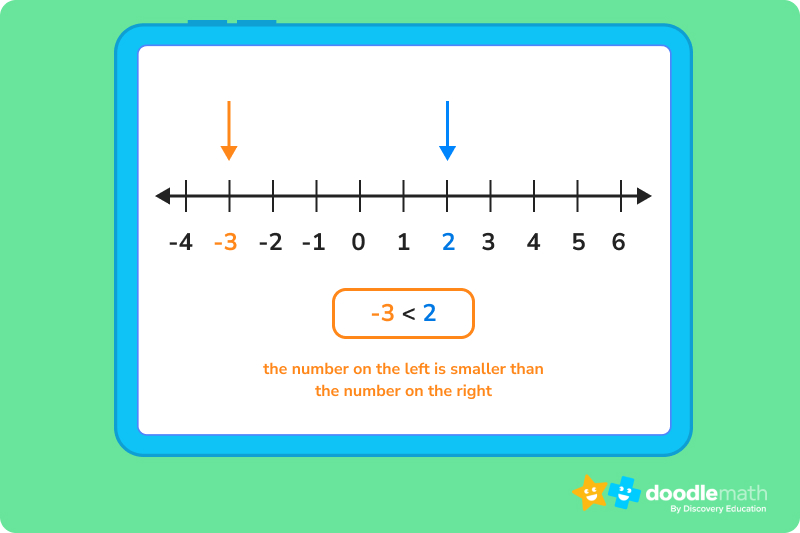

In this guide, learn all about the properties of integers and how to use them!

Author
Tess Loucka
Published
November 3, 2023


In this guide, learn all about the properties of integers and how to use them!

Author
Tess Loucka
Published
Nov 3, 2023


In this guide, learn all about the properties of integers and how to use them!

Author
Tess Loucka
Published
Nov 3, 2023


Key takeaways
Table of contents
You might not realise it, but you use integers every single day!
When you’re counting up your pocket money, checking how many more pages are left in a chapter you’re reading or even seeing how far you have to scroll through the TV channels to get to the programme you want to watch, you’re using integers.
To put it simply, an integer is a whole number. In school, you work with whole numbers all the time. But what makes integers a little more complicated is that they can also be negative numbers.
There are many rules and properties to remember when working with integers, but before we get started, what exactly is an integer?
An integer is any positive or negative round number, including zero.
A number with a fraction or decimal can’t be an integer, because it’s not a round number. After all, the word ‘integer’ literally means ‘whole’ in Latin, so the integer definition makes sense.
Unlock unlimited maths questions
Put your skills to the test with fun exercises + maths games that are proven to boost ability!
Try DoodleMaths for free!
Select a year group
To visualise integers, place them on a number line! A number line is a horizontal line that goes on for infinity on both sides. Numbers are placed on the line in relation to each other using equally distanced lines and spaces.
When setting up a number line, 0 is placed in the middle. As numbers get bigger, they move to the right. Smaller numbers go to the left.

When placing integers on a number line, you often start off with an integer set. Integer sets are lists of integers notated as Z = {list of integers}
Here’s an example integer set: Z = {-5, -2, 1, 3, 6}
As you get into more advanced integer graphing, you may come across the term greatest integer function. The greatest integer function is denoted as [x] = y. In this function, y is the largest integer that is less than or equal to x. Think of it as rounding down.
For example, [3.4] = 3 because 3 is the largest integer less than or equal to 3.4
[-3.4] = -4 because -4 is the greatest integer less than or equal to -3.4 (remember to move left on the number line!)
So, what is an integer operation, and how do you use integers in maths problems?
Integer operations are basic operations that can be done using integers.
To complete these operations, you’ll need to use the integers’ absolute values. The absolute value of an integer is the number value, or the distance away from zero. As a result, absolute value will always be positive.
So, 2 would be the absolute value of both |2| and |-2|. The absolute value of both |-43| and |43| is 43.
Adding integers of the same sign (positive or negative) will always result in an integer with that same sign.
(+3) + (+8) = +11
(-3) + (-8) = -11
Adding integers with different signs will result in an integer with the same sign as the number with the larger absolute value. To solve these questions, subtract the integers’ absolute values and use the sign of the number with the larger absolute value.
(+3) + (-8) becomes |8| – |3|, which is 5. The 8 is larger than the 3, and it is negative, so 5 becomes -5.
(-3) + (+8) also becomes |8| – |3|, which is 5. The 8 is larger, but it is positive, so 5 becomes +5.
When subtracting integers, change the sign of the second number and add the numbers together.
(+3) – (+8) becomes (+3) + (-8) = -5
(-3) – (-8) becomes (-3) + (+8) = 5
When multiplying integers, the result will be positive if both integers have the same sign. That’s true whether the sign is positive or negative. The result will be negative if both integers have different signs.
(+3) x (+8) = +24
(+3) x (-8) = -24
The rules for dividing integers are the same as they are for multiplying them. If both integers have the same sign, the result is positive. If both integers have different signs, the result is negative.
(+10) ÷ (+5) = +2
(+10) ÷ (-5) = -2
DoodleMaths is an interactive maths app that’s filled with questions covering integers, shapes and more!
Specifically designed for ages 4-14, it creates every child a unique learning experience tailored to their needs, building their skills in as little as six weeks. Try it for free today!


According to this property, when you add, subtract or multiply two integers together, the result will always be an integer. Dividing any two integers does NOT always result in an integer.
Eg. 8 + 4 = 12
8 – 4 = 4
8 x 4 = 32
8 / 4 = 2, but 4 / 8 = ½ or .5 (fractions and decimals are not integers)
According to this property, rearranging the grouping of integers doesn’t change the result when performing addition or multiplication.
In other words, a + (b + c) = (a + b) + c
Similarly, a x (b x c) = (a x b) x c
The placement of the parentheses doesn’t matter. The answer will always be the same. However, this is not true for subtraction or division.
Similar to the associative property, this property states that the order of integers in an addition or multiplication problem doesn’t affect the result.
So, a + b = b + a and a x b = b x a
This property states that when using the form a (b + c), the integer in place of “a” can be distributed to “b” and “c” to become (a x b) + (a x c).
Ex. 3 (2 + 8) = (3 x 2) + (3 x 8) = (6)(24) = 30
This property states that adding two of the same integers together with different signs always results in 0.
Ex. 2 + (-2) = 0. In this case, -2 is the additive inverse of 2.
(-2) + 2 = 0. In this case, 2 is the additive inverse of -2.
An additive inverse is any integer that, when added to another integer, results in 0.
This property states that any given number multiplied by itself over 1 is equal to 1. This is written as a + a/1 = 1.
Ex. 5 x 5/1 = 1
This property states that any integer plus 0 is equal to the integer itself, while any integer multiplied by 1 is equal to the integer itself.
Ex. 8 + 0 = 8
8 x 1 = 8
Click on the boxes below to see the answers!
Answer: +12
When subtracting two integers, change the sign of the second integer, and add the integers together. (+9) – (-3) becomes (+9) + (+3), which is equal to +12 or 12.
Answer: +4
When dividing two integers with the same sign, the result will always be positive. Three goes into 12 four times, so the answer is +4 or 4.
Answer: +1
Solve what is within the parentheses first. Multiplying two integers with different signs results in a negative number. So, (+2) x (-3) equals -6. Now, add +7 to -6 to get +1 or 1.
Integers are any positive or negative numbers, including zero. Integers aren’t fractions or decimals.
Yes, zero is an integer!
Consecutive integers are integers that follow each other in order from smallest to largest by 1.
Positive integers and 0 are whole numbers. Negative integers aren’t.
Yes, all integers are rational numbers because when turned into fractions, they have a denominator of 1.
Decimals are not integers. Integers must be round numbers.


Parents, sign up for a DoodleMaths subscription and see your child become a maths wizard!

Rational vs irrational numbers
Explore the differences between rational and irrational numbers
What is standard form?
Discover how standard form helps us represent numbers and equations clearly
Lesson credits

Tess Loucka
Tess Loucka discovered her passion for writing in school and hasn't stopped writing since. Combined with her love of numbers, she became a maths and English tutor. Since graduating, her goal has been to use her writing to spread knowledge and the joy of learning to readers of all ages.

Tess Loucka
Tess Loucka discovered her passion for writing in school and hasn't stopped writing since. Combined with her love of numbers, she became a maths and English tutor. Since graduating, her goal has been to use her writing to spread knowledge and the joy of learning to readers of all ages.
Book a chat with our team
If you’d like to use Doodle’s browser version, please visit this page on a desktop.
To log in to Doodle on this device, you can do so through our apps. You can find out how to download them here: